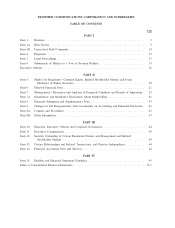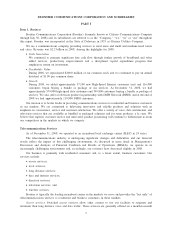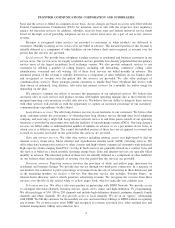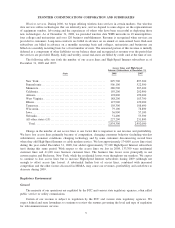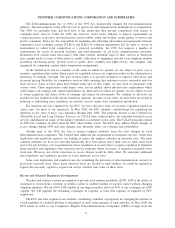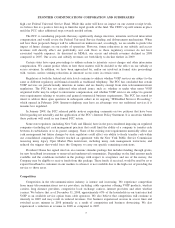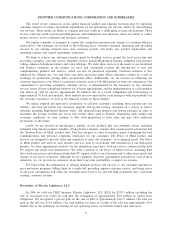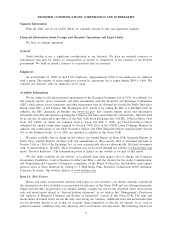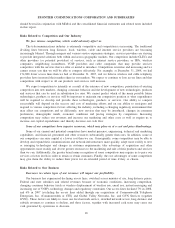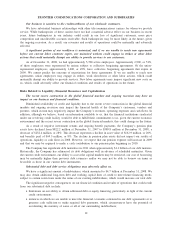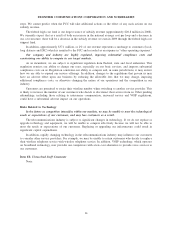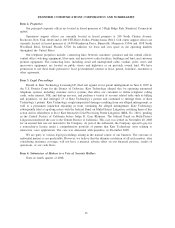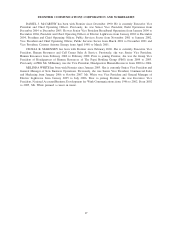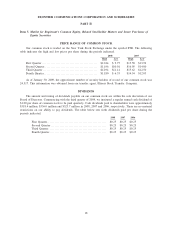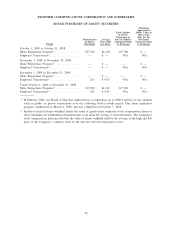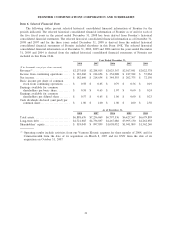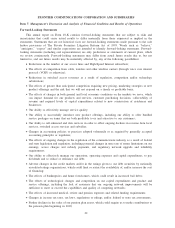Frontier Communications 2008 Annual Report Download - page 13
Download and view the complete annual report
Please find page 13 of the 2008 Frontier Communications annual report below. You can navigate through the pages in the report by either clicking on the pages listed below, or by using the keyword search tool below to find specific information within the annual report.Our business is sensitive to the creditworthiness of our wholesale customers.
We have substantial business relationships with other telecommunications carriers for whom we provide
service. While bankruptcies of these carriers have not had a material adverse effect on our business in recent
years, future bankruptcies in our industry could result in our loss of significant customers, more price
competition and uncollectible accounts receivable. Such bankruptcies may be more likely in the future, given
the ongoing recession. As a result, our revenues and results of operations could be materially and adversely
affected.
A significant portion of our workforce is unionized, and if we are unable to reach new agreements
before our current labor contracts expire, our unionized workers could engage in strikes or other labor
actions that could materially disrupt our ability to provide services to our customers.
As of December 31, 2008, we had approximately 5,700 active employees. Approximately 2,900, or 51%,
of these employees were represented by unions subject to collective bargaining agreements. Of the union-
represented employees, approximately 1,400, or 49%, have collective bargaining agreements that expire in
2009. We cannot predict the outcome of negotiations for these agreements. If we are unable to reach new
agreements, union employees may engage in strikes, work slowdowns or other labor actions, which could
materially disrupt our ability to provide services. New labor agreements may impose significant new costs on
us, which could adversely affect our financial condition and results of operations in the future.
Risks Related to Liquidity, Financial Resources and Capitalization
The recent severe contraction in the global financial markets and ongoing recession may have an
impact on our business and financial condition.
Diminished availability of credit and liquidity due to the recent severe contraction in the global financial
markets and ongoing recession may impact the financial health of the Company’s customers, vendors and
partners, which in turn may negatively impact the Company’s revenues, operating expenses and cash flows. In
addition, although we believe, based on information available to us, that the financial institutions syndicated
under our revolving credit facility would be able to fulfill their commitments to us, given the current economic
environment and the recent severe contraction in the global financial markets, this could change in the future.
As a result of negative investment returns and ongoing benefit payments, the Company’s pension plan
assets have declined from $822.2 million at December 31, 2007 to $589.8 million at December 31, 2008, a
decrease of $232.4 million, or 28%. This decrease represents a decline in asset value of $162.9 million, or 20%,
and benefits paid of $69.5 million, or 8%. The decline in pension plan assets did not impact our results of
operations, liquidity or cash flows in 2008. However, we expect that our pension expense will increase in 2009
and that we may be required to make a cash contribution to our pension plan beginning in 2010.
The Company has significant debt maturities in 2011 when approximately $1.1 billion of our debt matures.
Historically, the Company has refinanced its debt obligations well in advance of scheduled maturities. Given
the current credit environment, our ability to access the capital markets may be restricted, our cost of borrowing
may be materially higher than previous debt issuances and/or we may not be able to borrow on terms as
favorable as those in our current debt instruments.
Substantial debt and debt service obligations may adversely affect us.
We have a significant amount of indebtedness, which amounted to $4.7 billion at December 31, 2008. We
may also obtain additional long-term debt and working capital lines of credit to meet future financing needs,
subject to certain restrictions under the terms of our existing indebtedness, which would increase our total debt.
The significant negative consequences on our financial condition and results of operations that could result
from our substantial debt include:
•limitations on our ability to obtain additional debt or equity financing, particularly in light of the current
credit environment;
•instances in which we are unable to meet the financial covenants contained in our debt agreements or to
generate cash sufficient to make required debt payments, which circumstances have the potential of
accelerating the maturity of some or all of our outstanding indebtedness;
12
FRONTIER COMMUNICATIONS CORPORATION AND SUBSIDIARIES


